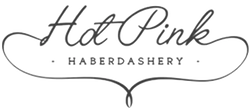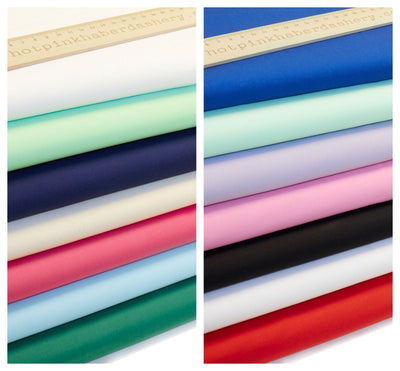The History of Sewing
Sewing is one of our favourite things here at Hot Pink Haberdashery. It’s a fantastic and calming pastime (considering all goes to plan of course!) and it produces some of our favourite haberdashery pieces. Sewing is a staple of what we do here and what we help facilitate you to do too - from clothing to cushions, bedding to baby shower presents, sewing is absolutely pivotal in within haberdashery.
Whilst we know how to sew and what it can do for us, what do we actually know about the history of sewing? The answer for us was: not very much - until we did our research! Sewing has a vast and interesting history, first arising in the Paleolithic era! We want to share this pretty cool history with you so that when you’re working away on your sewing machine or hand sewing your favourite stitch, you can remember this…

What is sewing?
Of course we know sewing as it is today, but breaking it right down to its fundamentals, sewing is the craft of fastening or attaching objects using stitches made with a needle and thread. As mentioned, it is one of the oldest textiles arts and it started in the caves. Before the more advanced spinning or weaving came about, archaeologists believe that our Stone Age ancestors across Asia and Europe sewed fur and skin clothing using bone, antler and Ivory needles, using ‘thread’ made from various animal body parts such as sinew, catgut and veins (thankfully that’s not the case anymore…).
Unsurprisingly, for thousands of years, sewing was always done by hand until the invention of the sewing machine in the 19th century and the rise of technology which led to mass production and export of sewn objects. Hand sewing is still practised around the world today and is associated with high quality tailoring, couture fashion and custom dress making (as well as being used as a means of creative expression like us!).

Origins of sewing
Sewing has been a necessity in cultures and societies for millions of years. It was used to stitch together animal hides for clothing, warmth and shelter. A great example of this is looking at Inuits, who would use sinew from caribou and those American Plains and Canadian Prairies used sophisticated sewing methods to assemble tipi shelters. Moving around the world, sewing was combined with the weaving of plant leaves in Africa to create baskets; thin strips of palm leaf would be used as thread to stitch wider strips of palm leaf to make the coil.
Moving North East from Africa, the weaving of cloth from natural fibres was originated around 4000 BC and even earlier, during the Neolithic Age was when the sewing of cloth accompanied this development.
Middle Ages
During this time, Europeans who could afford it, would employ seamstresses and tailors. Sewing was mainly a woman’s occupation and all sewing before the 19th century tended to be practical. Clothing was expensive so women had the important job of extending the longevity of items of clothing. Sewing was used for mending, reusing (such as making quilts etc.). Making clothes from scratch was long and tedious (weaving pattern making, cutting, alterations..) which meant that women were able to barter their expertise in particular skill with one another.
Decorative needlework such as embroidery was a highly valued skill at the time and from the Middle Ages up until the 17th century, sewing tools such as needles, pins and pincushions were included in the trousseaus of many European brides. Decirative embroidery was valued in countries and cultures all over the world - from Ireland to China, Morocco to Western Asia, cultures independent from each other found themselves with the same styles of stitching - pretty awesome!
Industrial Revolution
When we think of the The Industrial Revolution we think of heavy machinery, smoke and metal production - not necessarily of the textile industry that was born from it. The Industrial Revolution shifted the production of textiles from the household to the mills. The first sewing machine was patented in 1790 by Thomas Saint and but the early 1840s, other early sewing machines began to appear and by the 1850s, Isaac Singer developed the first sewing machine that not only surpassed the productivity of a seamstress or tailor, but could also be used at home.
Following this, textile sweatshops full of underpaid sewing machine operators grew into entire business districts in large cities, including London which further supported the industry. Mainly full of women working up to 14 hour days to earn enough to support themselves, this was a super tough time for working women. Tailors became associated with higher-end clothing and tailor shops popped up around Savile Row and coming into the 20th century and beyond, Savile’s tailor businesses are still flourishing.

What’s sewing today?
In the 20th century, sewing machines became more affordable to the working class so the demand for sewing patterns grew. An American tailor and manufacturer called Ebenezer Butterick created paper patterns that could be traced and used by home sewers. These became wildly popular and off the back of the demand, several pattern companies soon established themselves. As some of you might remember, women’s magazines also carried sewing patterns for much of the 20th century but declined when ready-made clothing became a necessity when more women joined the paid workforce, leaving them with less time to sew.
Today, the low price of ready-made clothing in high street shops and online, means that home sewing is largely confined to hobbyists in the Western world with the exception of cottage industries in custom dressmaking and upholstery!

We hope you found the history of sewing as interesting as we did and continue to carry on the millions of years’ tradition of sewing and creation. If you've been inspired to pick up a needle and thread from reading this, check out our selection of sewing tools here






That was very interesting, thanks for posting it.
Leave a comment